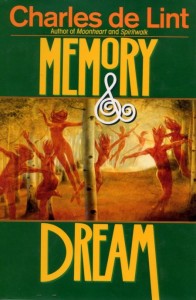 Jayme Lynn Blaschke penned this review.
Jayme Lynn Blaschke penned this review.
If there is an inherent flaw within the sub-genre of urban fantasy, it lies in the fact that many writers rely too heavily on established mythology. The familiar fantasy becomes a crutch, and holds the story back from fulfilling its true potential. The punk-rocker elf has become a cliché, as has the dragon living in the sewer. In Memory & Dream, Canadian fantasist Charles de Lint avoids this pitfall, and in doing so, sets himself apart from the crowd with his most complex, engaging and artistically challenging novel to date.
Using the colorful, mythical North American city of Newford as his background, de Lint draws up a rich tapestry of myth and magic, using painting–and, on a deeper level, creation–as a metaphor throughout the book. Following the life of starving artist Isabelle Copley, de Lint confronts head on the harsh realities of denial, abusive relationships, suicide and ultimately, responsibility for one’s own actions. Told partly in the present, partly in flashback, Isabelle’s life is fascinating in a frustrating way. De Lint refuses to clue the reader in one significant past events–such as the death of Katharine Mully — instead doling out piecemeal fragments of the story indirectly, colored by Isabelle’s perceptions. It’s a literary trick that works quite well, involving the reader as well as any mystery, an extended foreplay that’s as maddening as it is ultimately satisfying.
Which is fine for mainstream fiction, but de Lint readers expect a healthy dose of the fantastic to go with their prose. And de Lint delivers, eschewing gnomes and pixies. What if, he ponders, there exist non-corporeal beings, numena, who are able to take on form through the act of creation that goes into a painting? A being that is, by nature, very fey, but not of faerie–unless, of course, the painting it took its form from was of such a work. Added to this potent mix is enigmatic master painter Vincent Rushkin. A troll of a man who is alternately foul and fair, Rushkin takes Isabelle on as a student, teaching her how to unlock her true potential as an artist, as well as her hidden talent to bring forth numena. But Rushkin’s attentions raise questions of their own. How does he know of Isabelle’s talent? And are these numena real in their own right, or are they merely manifestations of her fertile artist’s imagination? And what happens to one if its painting is destroyed?
Needless to say, de Lint answers all the questions he poses–at least as much as some fundamental questions can be answered. Fans of de Lint’s short fiction will no doubt find this novel to their liking, and de Lint stocks the supporting cast with his usual on-the-fringes-of-society artistic types, including the popular Jilly Coppercorn and Geordie Riddell. But Memory & Dream goes places de Lint simply can’t explore in the short form, and successfully continues the more mature direction his career took with The Little Country and continued in Trader and Someplace To Be Flying . For any reader looking to join the ever-growing de Lint bandwagon, Memory & Dream is the perfect place to hop on.
(Tor, 1998)
